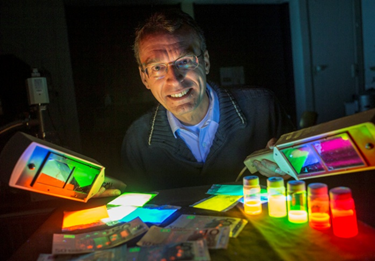报告题目:Multi Photon Phosphors
报告时间:2023年11月9日星期四 2:00 pm-4:00 pm
报告地点:新光电大楼930会议室
报告人:Andries Meijerink 院士
邀请人:禹德朝
报告内容:
Lanthanides have transformed the world of lighting in the past 40 years. Presently, almost all artificial light sources rely on emission of light by lanthanide ions. In many luminescent materials, also known as phosphors, one-to-one photon conversion downshifts one high energy photon to one lower energy photon in the desired spectral region. However, recently, there is a significant increase of attention for multi-photon phosphors relying on multi-photon conversion processes, either upconversion or downconversion. Insight in the multi-photon processes is not trivial but is needed to understand the mechanism and improve the efficiency of spectral conversion processes in multi-photon phosphors which is crucial for applications, including solar cells to reduce spectral mismatch losses.
In this presentation a short historical introduction to single- and multi-photon conversion phosphors will be followed by an overview of recent developments of efficient up- and downconversion materials. Next it will be discussed how insight can be obtained in the mechanism and efficiency of up- and downconversion processes. An important aspect involves modelling of energy transfer and ligand quenching. For both up- and downconversion examples will be given on how modelling of luminescence decay curves can provide quantitative insight. A new ligand-quenching model will be presented and applied to understand multi-phonon vibrational quenching in NaYF4:Er,Yb upconversion nanocrystals. Finally a new method will be presented that provides direct proof for downconversion. Correlated emission of photons in photon cutting materials can serve as a fingerprint for the occurrence of downconversion and can even be used to quantify the downconversion efficiency.

报告人简介:
Andries Meijerink received his MSc and PhD degree in Chemistry at Utrecht University. After a post-doc in Madison (University of Wisconsin) he returned to Utrecht in 1991. In 1996, at the age of 32, he was appointed at the chair of Solid State Chemistry in the Debye Institute of Utrecht University where he leads an active group in the field of luminescence spectroscopy of quantum dots and lanthanide ions.
In the field of lanthanide ions his work involves fundamental research on the energy level structure of both 4fn and 4fn-15d states and finding new concepts related to applications in solar cells, LEDs and scintillators. His research on quantum dots is aimed at unraveling the influence of quantum confinement and surface effects on the electronic structure and exciton dynamics of quantum dots through optical spectroscopy and using the quantum dots as labels in bio-imaging. Research on luminescence of doped nanocrystals integrates the two themes. Recent work has resulted in a better fundamental understanding of photonic effects on optical processes, insight in energy transfer processes and application of luminescent nanocrystals as probes and temperature sesnors. The work has resulted in over 380 publications and 10 patents and is highly cited. For his research Andries Meijerink received several awards, including the Shell Incentive Award (1995), the Gold Medal of the Royal Dutch Chemical Society (1999), the Centennial Award for Luminescence and Display Materials from the Electrochemical Society (2002) and the Gilles Holst Medal of the Royal Dutch Academy of Sciences (2019). In 2009 he was elected into the Royal Dutch Academy of Sciences.

